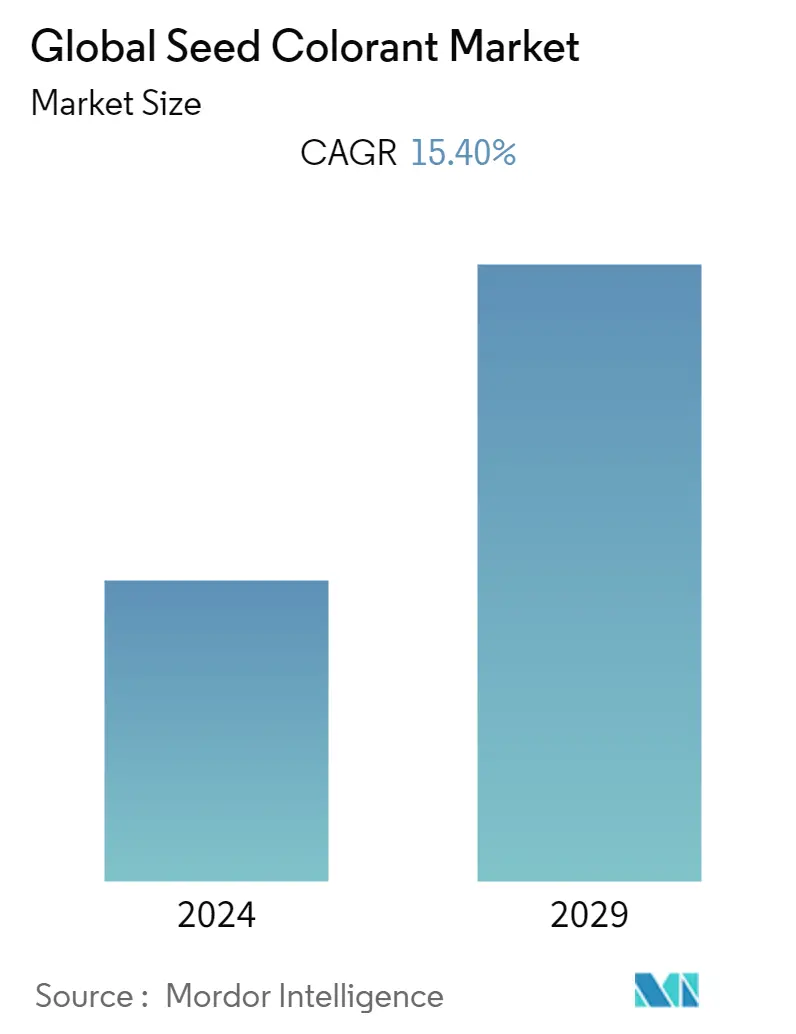Market Size of Global Seed Colorant Industry

| Study Period | 2019 - 2029 |
| Base Year For Estimation | 2023 |
| CAGR | 15.40 % |
| Fastest Growing Market | Asia Pacific |
| Largest Market | North America |
| Market Concentration | High |
Major Players*Disclaimer: Major Players sorted in no particular order |
Seed Colorant Market Analysis
The global seed colorant market (henceforth, referred to as the market studied) was valued at USD 271.3 million in 2018, and it is expected to register a CAGR of 15.4% during the forecast period. In 2018, North America was the largest geographical segment of the market studied and accounted for a share of around 40.7% of the overall market.
- Hybrid and GM are high-value seeds, which undergo various biological and chemical treatments that prevent losses. Colors are added to seeds for branding, identification, uniformity, and beautification. Hence, the use of seed colorants, dyes, and pigments is expected to increase in line with the adoption of hybrid and GM seeds.The adoption of increasingly pest-resistant and drought-tolerant hybrid seeds has helped farmers improve crop yields across diverse agro-climatic conditions, which in turn, boosts the demand for seed colorants.
- Preharvest seed treatment occupies the largest share in the global seed colorant market, as the treated seeds prevent adulteration of seeds and other hazards associated with the handling of treated seeds.
- The companies, like Clariant, are adopting seed colorants as part of their branding strategy, due to the increasing demand for unique colors.
Seed Colorant Industry Segmentation
The global seed colorant market operates in a business to business format. Owing to the increasingsupport from the government and the rising adoption rate of hybrid and GM seeds, the market studied is expanding exponentially. Even the companies are adopting seed colorants as a part of their branding strategy, in order to achieve higher sales and profit. However, the cost of the colorant is very high, as it comprises huge R&D and manufacturing costs. Thus, the high cost of seeds and an increase in prices of raw materials act asrestraints to the growth of the market studied.
| Time of Application | |
| Preharvest | |
| Pre and Postharvest |
| Formulation | |
| Powder | |
| Liquid |
| Crop Type | |
| Grains and Cereals | |
| Oil Seeds | |
| Fruits and Vegetables | |
| Turf and Ornamentals |
| Geography | |||||||||
| |||||||||
| |||||||||
| |||||||||
| |||||||||
|
Global Seed Colorant Market Size Summary
The global seed colorant market is experiencing significant growth, driven by the increasing adoption of hybrid and genetically modified seeds. These seeds undergo various treatments, including the application of colorants, to enhance branding, identification, and uniformity. The demand for seed colorants is further bolstered by the need for pest-resistant and drought-tolerant seeds, which help improve crop yields across different agro-climatic conditions. Preharvest seed treatment holds the largest share in the market, as it prevents seed adulteration and other handling hazards. Companies like Clariant are leveraging seed colorants as part of their branding strategies, responding to the rising demand for unique seed colors.
North America leads the global seed colorant market, with the United States at the forefront due to mandatory regulations and technological advancements. The market's growth is supported by government initiatives and awareness campaigns, such as the European Seed Treatment Assurance standard and India's country-wide seed treatment campaign. Major players in the market, including Incotec, Clariant, and BASF, are focusing on strategies like acquisitions, product development, and R&D expansion to enhance their market presence. The market is highly consolidated, with a few companies holding a significant share, and is expected to witness rapid growth due to the widespread adoption of seed treatment and advancements in seed coating technologies.
Global Seed Colorant Market Size - Table of Contents
-
1. MARKET DYNAMICS
-
1.1 Market Drivers
-
1.2 Market Restraints
-
1.3 Industry Attractiveness - Porter's Five Forces Analysis
-
1.3.1 Bargaining Power of Suppliers
-
1.3.2 Bargaining Power of Buyers
-
1.3.3 Threat of New Entrants
-
1.3.4 Threat of Substitutes
-
1.3.5 Intensity of Competitive Rivalry
-
-
-
2. MARKET SEGMENTATION
-
2.1 Time of Application
-
2.1.1 Preharvest
-
2.1.2 Pre and Postharvest
-
-
2.2 Formulation
-
2.2.1 Powder
-
2.2.2 Liquid
-
-
2.3 Crop Type
-
2.3.1 Grains and Cereals
-
2.3.2 Oil Seeds
-
2.3.3 Fruits and Vegetables
-
2.3.4 Turf and Ornamentals
-
-
2.4 Geography
-
2.4.1 North America
-
2.4.1.1 US
-
2.4.1.2 Canada
-
2.4.1.3 Mexico
-
2.4.1.4 Rest of North America
-
-
2.4.2 Europe
-
2.4.2.1 Germany
-
2.4.2.2 UK
-
2.4.2.3 France
-
2.4.2.4 Russia
-
2.4.2.5 Spain
-
2.4.2.6 Italy
-
2.4.2.7 Rest of Europe
-
-
2.4.3 Asia-Pacific
-
2.4.3.1 China
-
2.4.3.2 Japan
-
2.4.3.3 India
-
2.4.3.4 Australia
-
2.4.3.5 Rest of Asia-Pacific
-
-
2.4.4 South America
-
2.4.4.1 Brazil
-
2.4.4.2 Argentina
-
2.4.4.3 Rest of South America
-
-
2.4.5 Africa
-
2.4.5.1 South Africa
-
2.4.5.2 Rest of Africa
-
-
-
Global Seed Colorant Market Size FAQs
What is the current Global Seed Colorant Market size?
The Global Seed Colorant Market is projected to register a CAGR of 15.40% during the forecast period (2024-2029)
Who are the key players in Global Seed Colorant Market?
Bayer CropScience AG, BASF SE, Clariant, Precision Laboratories LLC and Croda International PLC are the major companies operating in the Global Seed Colorant Market.

